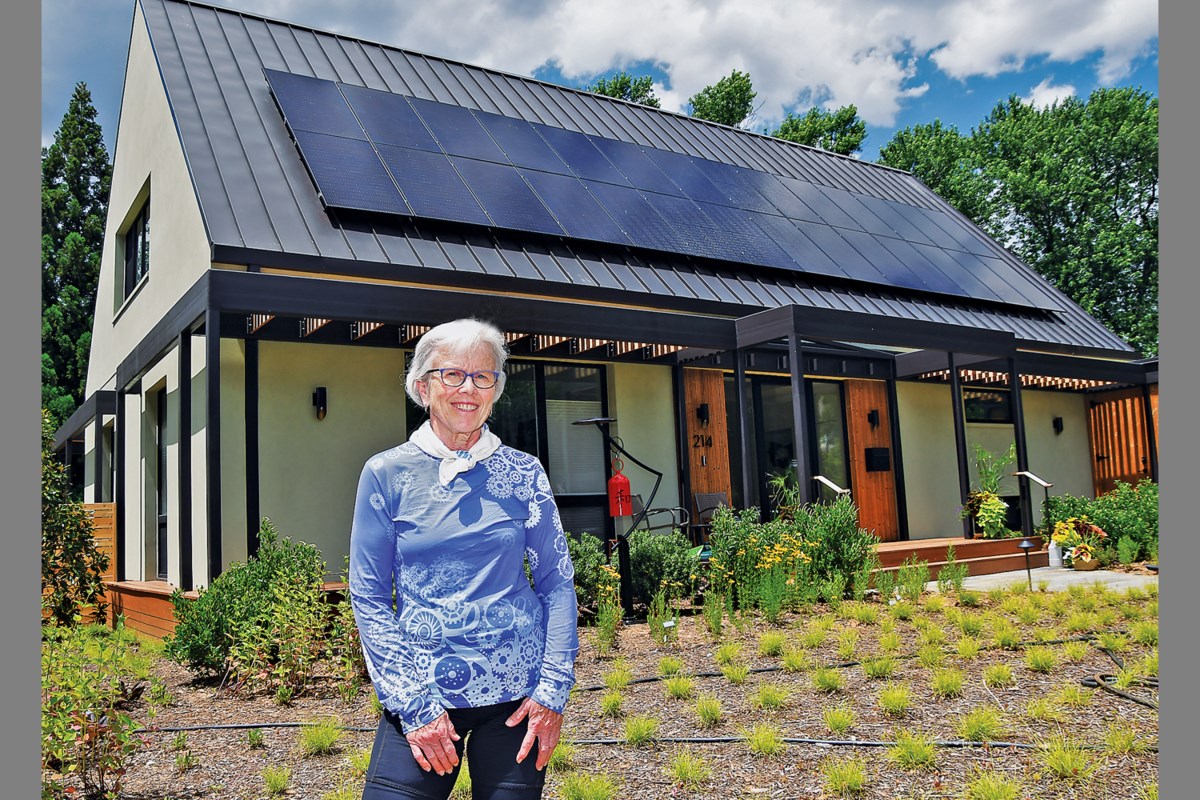Creating an energy-efficient home brings challenges, rewards

When former Vienna Conservation and Sustainability Commission chairman Susan Stillman had a new home built recently, she aimed to make it a stellar example of energy efficiency and environmental friendliness.
“This is the way change happens,” said Stillman, echoing remarks she made at this year’s Vienna Green Expo. “Somebody does something different.”
Peabody Fine Architects in Alexandria designed the house, located at 214 Ayr Hill Ave., N.E., and its constructed by AllenBuilt Inc. of Bethesda.
The house, which covers about 3,200 square feet of interior space (excluding the basement), received a ZERO 2021 design certification from Phius, a non-profit group that specializes in high-performance buildings that require little energy to heat or cool. The home rates 11 on the Energy Use Index, versus 45 for the average U.S. single-family house, indicating it uses 75 percent less energy.
A bank of solar panels dominates the south side of the home’s peaked roof. The house has all-electric appliances, continuous insulation, triple-paned windows, LED lighting and Energy Star appliances. There are 6 inches’ worth of insulation on the house’s exterior, 6 inches of Grade 1 insulation inside the home’s shell and even insulation under the concrete basement slab.
An energy-recovery ventilator removes stale air and brings fresh air into the tightly sealed house. Virginia’s building code permits a home’s air to leak out 3.5 times per hour; Stillman’s house, with its envelope-sealing “AeroBarrier” system, changes air once every five hours.
“My builder does something where he sprays this really fine mist and it finds any sort of little gaps, so there’s just no leakage in the house,” she said.
Stillman formerly lived in a house across the street. She bought this lot in 2019 and started working with the architect in 2020, but then the pandemic hit.
Crews broke ground for the house in 2023 and Stillman moved in this April. A final obstacle to getting an occupancy permit was meeting Vienna’s tree-canopy requirement, ironically put in place after advocacy from the Conservation and Sustainability Commission.
Stillman had the home designed so she could age in place. The house has an upper level (with more bedrooms and a seating area) and basement (currently unfinished), but she can do all activities on the main floor.
The house uses a heat-pump water heater, which harnesses warmth from inside the house. The heater’s output is regulated by an electric pump that notes when Stillman tends to use hot water.
Instead of a grass lawn, which would require regular upkeep and expense, Stillman’s yards are dotted with clumps of eastern star sedge, which eventually will fill in like regular grass but necessitates less mowing, she said.
Building a house to “net-zero” standards costs roughly 7 or 8 percent more than a regular home, but offers lasting utility savings, Stillman said.
Such houses require much stricter quality-control management and construction supervision, as the end result will be scrutinized by a third party, said John Allen, owner of AllenBuilt Inc.
“Everything is engineered the exact right size to minimize energy usage,” he said. “It’s kind of skating on the razor’s edge. There’s not a lot of room for mistakes.”
Controlling moisture is key to avoiding mold and rot, which are a “ticking time bomb,” Allen said. People who aren’t able to have their homes custom-built can keep household humidity in the desired range of 30 to 50 percent by using a “smart” thermostat that monitors humidity, he said.
Ivy Main, who with Stillman co-chairs the local Sierra Club’s renewable-energy efforts, said what she most likes about Stillman’s house is its air quality and ability to maintain comfort.
“She had to special-order a lot of things, but she’ll make back the uplift” with lower utility costs, Main said. “Going all-electric will be the biggest advantage from an indoor-air-quality perspective.”
Starting with a blank slate – in Stillman’s case, building a brand-new home on a cleared lot – makes it more practical to implement wholesale energy-efficiency measures and plant native species, Main said.
“There’s a limit to what you can do after the fact,” said Main, whose own house on a wooded property is not well-situated for solar energy.
For more information about the house, visit bit.ly/4d5XfH6.
link




:max_bytes(150000):strip_icc()/ms-vintage-trends-wallpaper-53d58593cd534a4ea1e06e4ba56a9efd.jpg)

